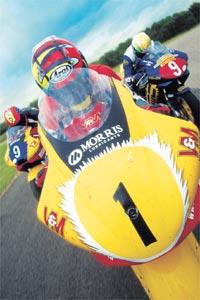Why 1/2 an inch subjects
Printed: 19 Might 2000
Up to date: 19 November 2014
of
TYRE measurement is without doubt one of the burning problems in 500 GPs this yr. If you happen to’ve watched any of the hot rounds on TV you’ll have heard commentators occurring about 16.5 and
17-inch rear wheels. So what’s the variation and which is easiest?
Aussie Garry McCoy used to be the usage of a 16.5 when he took his Purple Bull Yamaha to victory within the opening spherical in South Africa with a panoramic show of rear-wheel sliding.
However after the French GP at Le Mans, the argument over what rear tyre measurement is the only to move for used to be too with regards to name. Alex Criville’s luck in France made it 3 wins for the
17-inchers, whilst McCoy’s win at Welkom and Norick Abe’s in Japan make it two for the 16.5s.
Michelin first offered its unique 17in tyre again in 1984 – at a time when maximum groups ran 18in wheels. The 16.5s didn’t seem till the early ’90s. 1993 international champion Kevin Schwantz used to be some of the first converts and turned into the primary rider to win the usage of a 16.5in tyre on his Fortunate Strike Suzuki on the 1994 British GP at Donington Park.
The smaller tyre used to be advanced as a result of riders sought after extra grip to deal with ever-spiralling 500 energy outputs. Tyre generation simply couldn’t stay alongside of engine tendencies and riders have been continuously highsiding. The effects have been continuously painful as tyres slid when riders powered out of corners after which snapped again into line – launching their sufferer excessive of the motorbike.
Michelin’s preliminary solution used to be to extend the tyre-to-Tarmac touch patch with a 19cm large 17in tyre. The sort of used to be used to just right impact by way of Australian Daryl Beattie to win the 1993 German GP. However this wider tyre used to be heavier and technicians needed to make radical adjustments to the suspension set-up.
Going for a smaller diameter tyre allowed Michelin to stay the broader touch patch and stay weight at earlier ranges. The 16.5’s profile is radically other to the 17’s with a triangular form that places extra rubber at the monitor when the motorbike is cranked over on its aspect.
Michelin’s motorbike festival leader Nicolas Goubert explains: ” The 16.5s permit higher nook speeds. The bigger touch patch additionally assists in keeping temperatures extra constant, so riders can most often use a softer compound. ”
So if 16.5s are that just right why isn’t everybody the usage of them?
Goubert has the solution: ” The 17 provides higher using traction as soon as the rider has lifted the motorbike again up and opened the throttle. Maximum riders nonetheless choose this function. ”
And whilst 16.5s be offering extra grip in corners, it’s the 17s which flip in higher since the tyres are narrower.
” There are nonetheless some facets of the 16.5 on which we want to paintings, ” Goubert admitted. ” The additional rear-end grip could cause the entrance tyre to push, leading to understeer. And the 16.5 could cause front-end chatter. ”
Which means on tight and twisty tracks the 17 has a tendency to be a extra well-liked selection, whilst on speedy, sweeping circuits the 16.5 turns into extra commonplace.
Purple Bull Yamaha’s McCoy is the one full-time person of the 16.5, which he reveals absolute best for his wild, sideways taste. He informed MCN: ” I in finding the 16.5 has extra grip mid-corner, which is the place I love to get at the energy. The 17 is flatter at the most sensible of the tyre, so there’s no longer such a lot rubber at the floor once I’m cranked proper over. ”
However present sequence chief Kenny Roberts disagrees and makes use of a 17in tyre on his Suzuki RGV 500.
” The 16.5 rubber has higher grip in puts, ” he mentioned. ” However I nonetheless imagine the 17 is a quicker tyre. ”
So there’s no onerous and speedy rule. Whether or not a rider selections a 16.5 or a 17 is right down to a mixture in their taste and the type of monitor they’re racing on that weekend.
Supply By way of https://www.motorcyclenews.com/information/2000/would possibly/why-half-an-inch-matters/

/cloudfront-us-east-2.images.arcpublishing.com/reuters/PFL2PO4RJJPQDFJ3TJS22POBTU.jpg)

